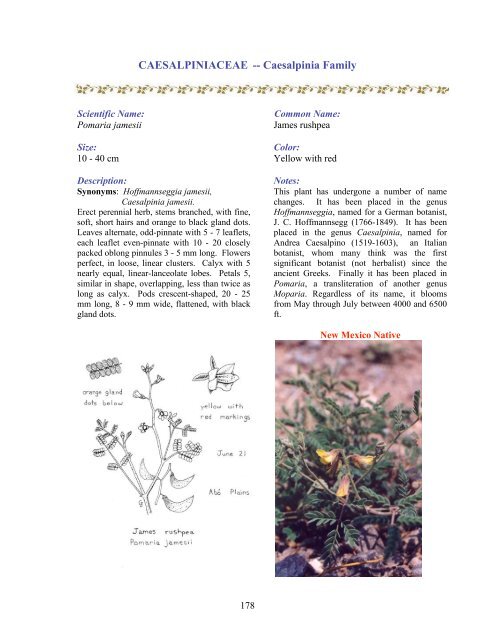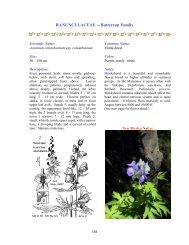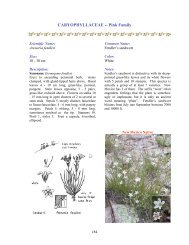BERBERIDACEAE -- Barberry Family - New Mexico Flores
BERBERIDACEAE -- Barberry Family - New Mexico Flores
BERBERIDACEAE -- Barberry Family - New Mexico Flores
Create successful ePaper yourself
Turn your PDF publications into a flip-book with our unique Google optimized e-Paper software.
Scientific Name:<br />
Pomaria jamesii<br />
Size:<br />
10 - 40 cm<br />
CAESALPINIACEAE -- Caesalpinia <strong>Family</strong><br />
Description:<br />
Synonyms: Hoffmannseggia jamesii,<br />
Caesalpinia jamesii.<br />
Erect perennial herb, stems branched, with fine,<br />
soft, short hairs and orange to black gland dots.<br />
Leaves alternate, odd-pinnate with 5 - 7 leaflets,<br />
each leaflet even-pinnate with 10 - 20 closely<br />
packed oblong pinnules 3 - 5 mm long. Flowers<br />
perfect, in loose, linear clusters. Calyx with 5<br />
nearly equal, linear-lanceolate lobes. Petals 5,<br />
similar in shape, overlapping, less than twice as<br />
long as calyx. Pods crescent-shaped, 20 - 25<br />
mm long, 8 - 9 mm wide, flattened, with black<br />
gland dots.<br />
178<br />
Common Name:<br />
James rushpea<br />
Color:<br />
Yellow with red<br />
Notes:<br />
This plant has undergone a number of name<br />
changes. It has been placed in the genus<br />
Hoffmannseggia, named for a German botanist,<br />
J. C. Hoffmannsegg (1766-1849). It has been<br />
placed in the genus Caesalpinia, named for<br />
Andrea Caesalpino (1519-1603), an Italian<br />
botanist, whom many think was the first<br />
significant botanist (not herbalist) since the<br />
ancient Greeks. Finally it has been placed in<br />
Pomaria, a transliteration of another genus<br />
Moparia. Regardless of its name, it blooms<br />
from May through July between 4000 and 6500<br />
ft.<br />
<strong>New</strong> <strong>Mexico</strong> Native




